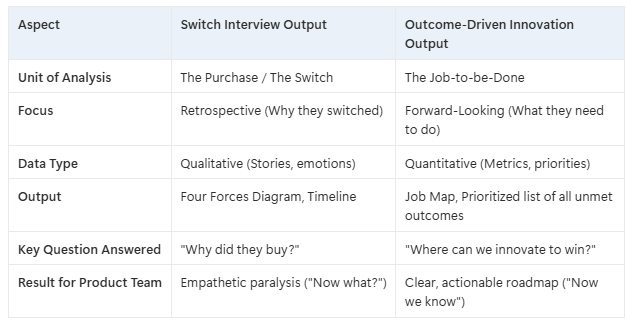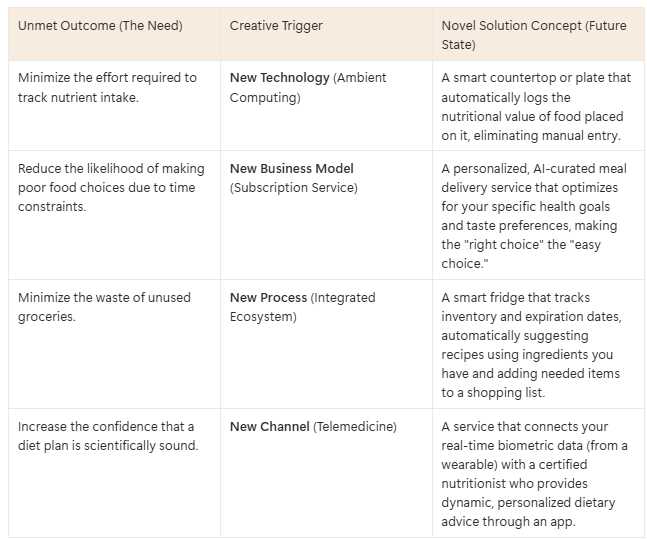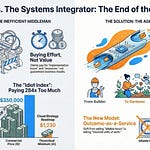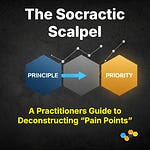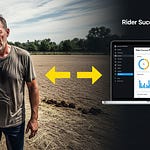Many “innovation consultants” swear by Switch Interviews. I built my career by consciously avoiding them. Here’s the fundamental flaw I saw from the start and the more rigorous system I chose instead.
The "Now What?" Problem I Sidestepped
Early in my innovation career, Switch Interviews were gaining serious traction. Everyone seemed to be talking about them. Intrigued, I did what I always do with a promising new tool: I took it apart from first principles.
I didn't run a single interview. Instead, I sat down with a whiteboard and mapped the entire process. I analyzed the inputs it was designed to capture: retrospective, emotional stories about a past purchase. Then I analyzed the outputs it was supposed to generate: a clear, actionable roadmap for a product team.
The gap between the two was staggering.
I saw a methodology that was brilliant at creating a psychological narrative, but I couldn't see a reliable mechanism to translate those stories into a complete, prioritized, and quantitative set of customer needs. There was no bridge from the qualitative "why" of a past decision to the quantitative "what" and "how" of a future solution.
I saw a dead end. A project-killing question that the methodology was fundamentally unequipped to answer: "So, what do we build?"
I could see teams ending up with rich, empathetic stories but facing total strategic paralysis. They'd be stuck in the "Now What?" chasm. And so, from day one, I made a conscious choice to sidestep that trap. I rejected Switch Interviews not because I had a bad experience with them, but because my initial analysis showed me that a bad experience was inevitable for any team whose goal was to innovate, not just to understand. I chose a different path, one built on a more rigorous and predictive foundation.
An Honest and Generous Appraisal of Switch Interviews
Before we deconstruct the tool, let's analyze it objectively. Switch Interviews, rooted in the Jobs-to-be-Done philosophy, are exceptionally good at one thing: uncovering the narrative of a purchase.
What Switch Gets Right
The core idea is to treat a customer's purchase as a "switch" from an old way to a new way. By interviewing them about this moment, you can uncover the forces that contributed to the decision. The centerpiece is the Four Forces model:
Push: The problem with the current situation.
Pull: The appeal of the new solution.
Anxiety: The fears about the new solution.
Habit: The inertia of the current solution.
When you map these forces, you get a powerful psychological profile of the buying decision. It’s a fantastic tool for marketing and sales teams. It helps you write copy that speaks directly to the customer's struggle and craft messaging that highlights the pull of your solution. It uncovers the "why" behind the buy.
But that's where its utility ends. And for a product or R&D team, that's where the problems begin.
The Inherent Limitations
The very things that make Switch Interviews great for understanding a past purchase make them fatally flawed for planning a future product.
It's a Rear-View Mirror: The entire process is retrospective. It asks customers to recall feelings about the past. But innovation must be forward-looking. Relying solely on past behavior is like trying to drive a car by only looking in the rearview mirror.
The Unit of Analysis is Wrong: It studies the "switch"—a single, solution-centric event. But customers don't live in "switch" moments. They are trying to get things done. The "switch" is one tiny point in a much larger process, or "Job." Focusing only on that moment misses the vast landscape of opportunity across the entire Job.
The Data is Incomplete for R&D: This is the critical flaw I saw from the start. The output is a set of qualitative stories. Stories are powerful for empathy, but they are not a stable, complete, or quantifiable set of requirements. You can't ask an engineering team to "build a solution that reduces anxiety." They need specifics. They need metrics. They need a prioritized list. Switch Interviews don't provide this. They are designed to leave you with insightful anecdotes and that paralyzing question: "Now what?"
The Core Argument — A First-Principles Deconstruction of "Customer Insight"
To build a better system, we must start from the ground up. By using First-Principles Thinking, we can strip away the flawed assumptions baked into popular methods and build on a foundation of undeniable truths.
Challenging the Foundational Assumptions of Switch
Assumption #1: "The Customer" is the unit of analysis.
Refutation: This seems obvious, but it's a trap. Customers are heterogeneous and their preferences change. The "customer" is too unstable an anchor for innovation. Trying to find the "average customer" is a recipe for an average product. Besides, is there even a customer yet?
First Principle: The "Job-to-be-Done" is the true unit of analysis. The core Job a customer is trying to get done is remarkably stable over time. People have been trying to "share information" for centuries; the solutions evolve, but the Job remains. Focusing on the Job provides a stable, predictable foundation.
Assumption #2: The "Purchase Decision" is the most critical event to study.
Refutation: Focusing on the purchase is like analyzing a wedding to understand a marriage. It's a dramatic moment, but it's only one data point in a much longer process. The real opportunities for innovation happen every time the customer executes the Job.
First Principle: The entire process of executing the Job is the critical process to study. This "Job Map" is a step-by-step breakdown of what the customer is trying to accomplish. Analyzing this entire process reveals every point of struggle, not just the one that triggered a switch.
Assumption #3: "Why" they switched is the most important insight.
Refutation: "Why" gives you context, but not direction. Knowing why a customer felt frustrated doesn't tell you how to solve it in a way that is measurably better than the competition. "Why" is qualitative and incomplete.
First Principle: A complete set of desired outcomes is the most actionable insight. These are the stable, measurable metrics customers use to judge success in a Job. An outcome statement is a specific, solution-agnostic need, like "Minimize the time it takes to..." or "Reduce the likelihood that...". A complete set of these outcomes forms a perfect, data-driven specification for what a winning product must do.
The System That Works — An Introduction to Outcome-Driven Innovation (JTBD)
When you build an innovation process from these first principles, you arrive at Outcome-Driven Innovation (ODI), the most rigorous application of Jobs-to-be-Done theory. This is the system I chose from the start because it provides the predictive, quantitative model that other methods lack.
From Anecdotes to Algorithms
ODI transforms innovation from a guessing game into a systematic process. It gives you the "what to build" and the "why it will win" before you start development.
The Core Components
Defining the Job: First, define the market around the Job-to-be-Done, not a product or demographic. This is best done using a first principles deconstrucion of the problem-space
Creating the Job Map: Work with fundamental truths to reconstruct a job map for each phase. This creates a stable framework for analysis and eliminates all potential bias from customes and/or practitioners.
Uncovering Desired Outcomes: For each step, uncover all the customer's desired outcomes—their metrics for success. These are now traceable back to their fundamental truths.
Quantifying Opportunity: This is the crucial step. Survey a statistically significant sample of the market. Ask them to rate each outcome on its importance and their current satisfaction (or effort). The gap between importance and satisfaction reveals the biggest opportunities for growth with mathematical certainty.
Direct Comparison Table
The difference is stark.
Designing Future-Proof Solutions
This data-driven understanding of customer needs doesn't just lead to incremental improvements; it unlocks breakthrough innovation.
Thinking in New Dimensions
When you know, with mathematical certainty, which outcomes are most underserved, you can think differently about solutions. You can brainstorm concepts that get the Job done in a completely novel way, often by abstracting the Job away entirely.
Creativity Matrix in Action
You can systematize this ideation by combining your JTBD insights with other creative triggers. This matrix helps you explore possibilities beyond the obvious.
Job-to-be-Done: Maintain a healthy diet.
Building a Competitive Moat with Doblin's 10 Types of Innovation
The deepest insights from the ODI universe of JTBD allow you to build a powerful, defensible moat by innovating across multiple fronts. Doblin's 10 Types of Innovation framework shows that breakthrough success rarely comes from product innovation alone. Knowing your customers' top unmet outcomes allows you to strategically combine these types to create a solution that is far harder for a competitor to copy than just a slick user interface.
From "Why?" to "How" to "Wow"
I never adopted Switch Interviews because a first-principles analysis revealed their fatal flaw: they cannot bridge the gap between a qualitative story and a quantitative product roadmap. They are a tool for understanding the psychology of the past, not for architecting the innovation of the future.
The journey from the retrospective, qualitative world of Switch to the predictive, quantitative framework of ODI/JTBD is a journey from "Now what?" to "Now we know." It's about trading anecdotes for data, hunches for a roadmap, and guesswork for a formula. It’s the foundation I chose for my career, and it's how you can stop chasing competitors and start building the future.
If you’d like to learn more, don’t hesitate to reach out.
Follow me on 𝕏: https://x.com/mikeboysen
If you'd like to see how I apply a higher level of abstraction to the front-end of innovation, please reach out. My availability is limited.
Mike Boysen - www.pjtbd.com
De-Risk Your Next Big Idea
Masterclass: Heavily Discounted $67
My Blog: https://jtbd.one
📆 Book an appointment: https://pjtbd.com/book-mike
Join our community: https://pjtbd.com/join



